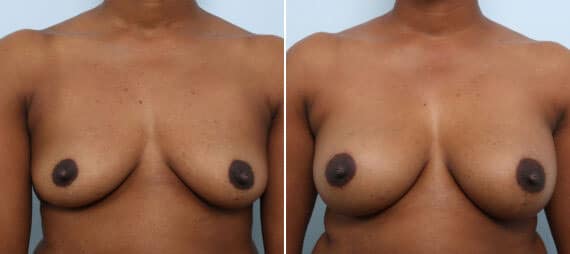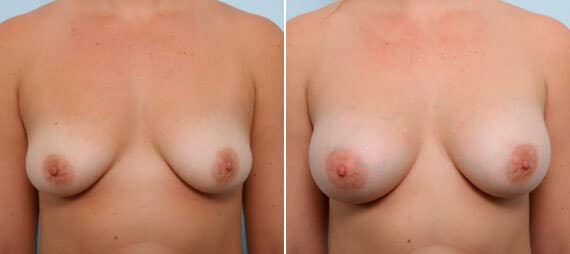Breast Augmentation
in Houston
Dr. Paul Vitenas is a leading breast augmentation specialist in Houston, Texas, who tailors his approach to each woman’s unique aesthetic goals. With over 35 years of experience and more than 500 breast augmentation procedures performed annually, he is renowned for achieving natural-looking results.
Texas Super Doctor
Breast Augmentation Before & After Results
Each Patient is Unique and Individual Results May Vary
Discover Why Patients From Across Texas Choose Dr. Vitenas for Natural-Looking Breast Augmentation
Benefits of Breast Augmentation with Dr. Vitenas
- Enhancing Size and Curves: Many women opt for implants to increase the size of naturally small breasts, adding fullness for a more proportionate and curvy figure.
- Restoring Lost Volume: Pregnancy, weight loss, and aging can cause a loss of breast volume. Augmentation can restore a fuller, more youthful look.
- Correcting Asymmetry: Breast augmentation can balance uneven breast sizes for a more symmetrical appearance.
- Improving Body Proportion: Enhancing the breasts with implants can create a more balanced silhouette that complements the overall body shape.
- Gender Affirmation: Transgender women may opt for implants to achieve a more feminine look.
Many of Dr. Vitenas’ patients share that their breast augmentation has significantly boosted their confidence and self-esteem, making them feel more comfortable and satisfied with their appearance. Dr. Vitenas tailors each procedure to the individual, ensuring results that enhance your natural body shape and meet your specific aesthetic goals.
Whether you’re seeking a curvier, sexier, more voluptuous figure or simply want to feel more confident in your own skin, the benefits of breast augmentation can be truly life-changing.
Why Choose Dr. Vitenas For Your Houston Breast Augmentation?
When you choose Dr. Vitenas for your procedure, you are getting a caring professional who will take the time to understand your very personal goals and aspirations, along with a dedicated team who will support you through every step of the process.
Dr. Vitenas has been recognized as one of America’s Top Plastic Surgeons, a Texas Super Doctor, a RealSelf Top Doctor for Breast Implants, and a Castle Connolly Top Doctor several years in a row. He was awarded the coveted Top Doctor honor for Plastic Surgeons in Houstonia Magazine, which came from the publication surveying the doctor’s peers. Nearly two dozen plastic surgeons with highly skilled ratings in the field have also endorsed Dr. Vitenas’ skills specifically as a plastic surgeon.
He is renowned for his exceptional artistic vision and advanced surgical skills. Dr. Vitenas is dedicated to enhancing each patient’s natural beauty, ensuring they look their best today, and continue to do so for decades to come. He has completed multiple Maxillofacial, Craniofacial, and Cosmetic Surgery fellowships at the University of Miami and Paris, France, with world-famous plastic surgeons. This extensive training enables him to create truly life-changing outcomes for his patients.
Dr. Vitenas’ extensive experience, comprehensive implant selection, advanced surgical techniques, state-of-the-art facility, and commitment to patient satisfaction distinguish him as a leading plastic surgeon in Houston.
- Breast Augmentation Expertise: Dr. Vitenas is a board-certified plastic surgeon with over 35 years of experience in breast augmentation and other cosmetic surgeries. He has performed more than 10,000 successful breast surgeries.
- Extensive Implant Selection: Dr. Vitenas offers over 250 implant sizes, profiles, and types for patients to consider during their consultation, ensuring personalized options for everyone.
- No Pain with Local Anesthesia: The breast augmentation procedure typically takes 40 to 50 minutes, with minimal pain thanks to long-acting local anesthesia.
- Minimal Downtime: Many patients can return to office-based work by Monday if surgery is performed on Friday.
- State-of-the-Art Facility: Equipped with the latest technology, Dr. Vitenas operates in a 15,000 sq ft accredited surgical center located at 4208 Richmond Ave in Houston with easy access from the Southwest Freeway and I-610.
- Innovative Techniques: The doctor uses advanced methods to minimize contact with implants and employs post-surgical breast implant exercises to reduce capsular contracture risk and to ensure a natural-looking breast.
- Patient Testimonials: Dr. Paul Vitenas has garnered over 900 five-star reviews from Houston patients on Google, personally reading each one. These heartfelt testimonials have been a driving force behind his daily dedication to cosmetic breast surgery for more than 35 years.

"Wonderful experience with Dr Vitenas and his staff upstairs. From the very first enquiry to my last checkup appointment they have been amazing! I got a breast augmentation done and they look great I am not going to lie I was very nervous to get this done but both Dr Vitenas and his staff made me feel at ease and was so knowledgeable. Also I was looking for a Dr. who does natural looking breasts and they look beautiful and very natural! I highly recommend Dr Vitenas and would recommend him to all my friends!"
No need to worry! Our friendly and experienced patient coordinators are here to help. Whether you need assistance with travel plans or local reservations, we’ve got you covered. Let us make your experience as stress-free as possible!
Candidates for Breast Augmentation
Women hoping to get pregnant or breastfeed in the future can still be good candidates. Be sure to address these topics with Dr Vitenas during your consultation. The minimum age requirement for breast implants varies depending on the type of implant chosen: 18 years of age for saline-filled implants, and 22 years of age for silicone implants.
The best way to determine if you are a candidate for breast augmentation is to schedule an in-person consultation with Dr. Vitenas, a board-certified plastic surgeon who will evaluate your procedure pros and cons, examine your breasts, and help you determine whether implants can help you to achieve your cosmetic goals. Ideal candidates for breast augmentation surgery are women who:
- Are physically healthy
- Have breasts that are fully developed
- Have realistic goals for enhancement
- Do not smoke or are willing to quit smoking
- Are not currently pregnant or breastfeeding
Silicone Breast Implants at Vitenas Cosmetic Surgery
Silicone breast implants are a popular choice and they come in a variety of shapes, sizes, profiles, and textures to accommodate each patient’s unique anatomy and aesthetic goals. Dr. Vitenas will help you to determine which silicone breast implants are right for you based on your body type, breast characteristics, and cosmetic goals. He employs advanced techniques to minimize the risk of complications and enhance surgical outcomes.
- Natural Feel: Silicone implants closely mimic the feel of natural breast tissue and have a softer, more natural feel compared to saline.
- Natural Appearance: Silicone implants provide a more natural slope, shape, and movement of the breasts.
- Reduced Wrinkling: These implants are less likely to wrinkle or ripple compared to saline implants, especially for women with minimal breast tissue.
- Variety: Silicone implants are available in round and teardrop shapes to optimize your appearance.
- Age Approval: Women who are 22 years of age and older are approved for breast augmentation with silicone implants.
- Long-Lasting Shape: Silicone implants may be better able to maintain their shape and fullness in the upper portion of the breast over time.
Your Free Breast Augmentation Consultation With Dr. Vitenas
A breast augmentation consultation allows patients to meet with Dr. Vitenas, learn about their options, and determine if they are good candidates for enhancement with implants.
Our modern Houston office building includes a discreet entrance and a covered parking garage. It is conveniently located near River Oaks within the 610 Loop, between Downtown and Uptown.
At your consultation, Dr. Vitenas will:
- Discuss Your Goals: Be prepared to share your hopes for breast enlargement and the results you’d like to achieve.
- Evaluate Your Health: Dr. Vitenas will review your overall health, medical history, and any medications to ensure you’re a suitable candidate for surgery.
- Perform a Physical Exam: The doctor will assess your breasts, take measurements, and recommend implant size, shape, and placement options tailored to your goals.
- Provide a Procedure Overview: Dr. Vitenas will explain the entire breast augmentation process—from preparation through recovery—and answer all your questions.
- Create a Customized Surgical Plan: You’ll review implant suggestions, incision placement, and the possibility of using fat transfer for more subtle enhancements.
- Discuss Next Steps: You'll receive information about costs, financing options, and the scheduling process, along with before-and-after photos to visualize potential results.
Dr. Vitenas will thoroughly discuss your implant options and make recommendations about the size, shape, material, and breast implant placement that will help you achieve your goals.

What is the Best Breast Implant Option for Me?
The right type of implant depends on the following:
- Your current breast size and amount of natural tissue
- The dimensions of your chest and width of the implant base
- The volume enhancement desired
- The look and feel you hope to attain
- Your lifestyle (active, athletic, etc.)
- Your body type and frame size
While Dr. Vitenas highly recommends Natrelle, he also offers other top breast implant brands. He is recognized as one of the leading providers of Natrelle implants in the country.
Rest assured, you’re in highly skilled and experienced hands. The final decision will always be a collaboration between you and Dr. Vitenas, ensuring the best choice for your needs and goals.
Combining Breast Implants with Fat Transfer for Natural Results
At our practice, Dr. Vitenas uses silicone or saline implants in combination with fat transfer to enhance the shape and volume of the breasts. During consultations, patients can try on over 250 different implant sizes and visualize their desired results before surgery. This personalized approach ensures that every patient achieves the look they want from their breast augmentation in Houston.
Generally, implants have structure and can be confined within a space. This increases the breast’s size and helps shape it, providing the rounded, lifted appearance many patients desire. Very few people rely solely on fat transfer to the breast because fat lacks structural stability. This means it takes the shape of whatever space it occupies. While it can add volume, it does not create or maintain the overall shape of the breast.
Fat is most effective when used to enhance specific areas, such as the medial (inner) part of the breast or the upper pole. Fat grafting and a lift can also be used to maintain a natural-looking breast contour after removing implants. However, if you try to achieve a larger breast solely with fat, the result is often a small breast with added bulk, rather than an increase in size and shape.
Implants are preferred because their structure provides the definition and shape that fat alone cannot achieve. Fat transfer works best as a complementary technique to improve cleavage and achieve a more natural breast enhancement. Even in breast reconstruction, implants are often placed first, with fat added afterward to refine the appearance and create a more natural look. This means fat transfer is not a replacement for breast implants in Houston.
It is also important to understand that cleavage largely depends on the shape of your rib cage. Many people assume their rib cage is flat, but it’s usually angled slightly, and sometimes one side is angled more than the other. How your chest muscles attach to the breastbone also determines how far apart your breasts naturally sit. When an implant is placed under the muscle, it is held in place by these attachments, which means the implants cannot be positioned any closer together than the natural structure allows.
While it is possible to place implants above the muscle, this approach can make the edges of the implant more visible, especially if there isn’t much natural breast tissue. For this reason, we place implants under the muscle in about 99% of cases.
And if a breast implant is under the muscle and a patient still has a wider cleavage than desired, we may perform fat grafting to the breast. Dr. Vitenas will strategically add fat to the inner area of the breasts and taper it upward, creating the appearance of closer-set breasts and a more defined cleavage.
For professional athletes or anyone concerned about maintaining full muscle strength, we sometimes place implants above the muscle. Cutting the muscle in these cases can reduce strength, so placing implants on top helps preserve functionality while still achieving a natural look.


Breast Augmentation Procedure Details
- Step 1: Administer Anesthesia. You’ll be given general anesthesia, ensuring that you’re completely comfortable and asleep throughout the procedure.
- Step 2: Make Incisions. Small incisions are made, usually in the breast crease. These are chosen to keep scars as hidden as possible. If you’re also having a breast lift, additional incisions will be made.
- Step 3: Create the Breast Pocket. A breast pocket is created either above or below the chest muscle (chest wall), based on your anatomy and the desired result.
- Step 4: Insert and Position the Implants. The implant (silicone or saline) is inserted into the breast pocket and carefully positioned to achieve a balanced and natural look.
- Step 5: Close the Incisions: Once the implants are in place, the incisions are closed using sutures and surgical tape to promote healing and minimize scarring.
- Step 6: Recovery. After the surgery, which usually takes less than an hour, you’ll spend some time, usually 20-30 minutes in a recovery area before heading home the same day.
Breast Augmentation Recovery Process
- Rest for the first 24-48 hours, with assistance if needed.
- Go braless as instructed post-surgery. Dr Vitenas does not use a post operative bra as this will inhibit the final natural looking result.
- Take prescribed pain medications and antibiotics.1
- Swelling, bruising, numbness, and mild discomfort are normal and will subside.
- Avoid blood thinners (asprin, advil, aleve, BC powders, ibuprofen) and salty foods for 6 weeks.
- Normal activities can resume after 1-2 days; wait 6 weeks before resuming strenuous exercise.
- Attend follow-up appointments to monitor progress.
Call the office promptly about severe pain, excessive swelling, discharge, fever, or other concerns. The risk of hematoma after breast augmentation, though rare, is a potential complication you might encounter.

Post-Surgery Recovery Timeline and What to Expect
Immediately After Surgery:
You’ll see a preview of your results, but your breasts may look high and tight due to swelling and compression of the tissues depending on the amount of native skin you have and the size of the implant which was chosen.
1-2 Weeks Post-Surgery:
Initial swelling begins to subside, though results may still appear tight or swollen.
1-3 Months:
Swelling continues to decrease, and the implants start to settle into place. Some mild shifting or settling of the implants is normal during this time. Sensation often begins to return, though some numbness may persist.
3-6 Months:
Swelling should be mostly gone, and your breast shape will become more natural as the implants settle further.
6-12 Months:
Final results are typically visible. Incision lines will continue to fade and mature into thin, white scars.
12 Months and Beyond:
By this point, most patients see their full, final results, including the full fading of scars and the permanent settling of the implants.
Patience is key throughout the healing process, as it takes time for swelling to completely resolve and for the implants to settle into their final position.
How Much Does Breast Augmentation Costin Houston?
The starting cost of breast augmentation with Dr. Vitenas in Houston is $7,000, but varies based on several factors, including:
- Type of Implants: Certain silicone implants may cost more due to their level of “cohesivity” or “denseness”.
- Surgical Facility Fees: These cover the use of the operating room and related facilities.
- Surgeon's Expertise: Highly experienced surgeons may charge higher fees reflecting their skill and reputation.
- Combining Procedures: If combined with other procedures like a breast lift, the cost may be higher.
If you have children or pets, you may need to arrange for someone to care for them while you recover from surgery, which can add to your expenses if you don’t already have a regular babysitter or pet sitter. Additionally, after breast augmentation, your plastic surgeon will likely prescribe pain medication to help manage any discomfort, which may also contribute to the overall cost of your recovery.
Dr. Vitenas, a highly skilled breast surgery specialist, employs safe and effective techniques with exceptional care and precision to achieve stunning, natural-looking results. He offers each patient the personalized attention they deserve, and his pricing reflects his advanced expertise and dedication to excellence. During your consultation, Dr. Vitenas will address your specific needs and offer a detailed quote.
At Vitenas Cosmetic Surgery, we offer a variety of payment and financing options to meet each individual’s unique needs, including cash, all major credit cards, and cashier’s checks. For your convenience, we also provide healthcare financing through reputable companies such as CareCredit, Cherry, and Alphaeon Credit. Medical financing allows patients the freedom to choose the procedure they want today without delay. Applying is easy, approval is fast, and the low-interest payments are designed to be affordable for everyone.
For a more in-depth understanding of the factors influencing the cost of breast augmentation, you might find the following video informative:
1 Paul Vitenas, “Four Tips for a Healthy Recovery after a Breast Augmentation,” American Society of Plastic Surgeons, December 12, 2017, https://www.plasticsurgery.org/news/blog/four-tips-for-a-healthy-recovery-after-a-breast-augmentation.
Breast Augmentation Common Questions
Who is the best breast surgeon in Texas?
Dr. Paul Vitenas, with over 35 years of experience and more than 10,000 breast surgeries performed, is highly regarded as one of the top board-certified plastic surgeons in Texas. His extensive expertise and dedication to achieving aesthetically pleasing, natural results make him a premier choice for breast surgery in Texas and throughout the United States.
How do you choose the right size for breast implants?
The right size depends on your body frame, chest wall, existing breast tissue, and desired outcome. Dr. Vitenas listens to your preferences, suggests suitable sizes, and allows you to try on different implant sizers to see what works best for you. This helps ensure that the chosen size complements your body shape, whether you’re aiming for a more natural look or larger breasts.
How can I prepare for my breast augmentation procedure?
Like any other surgical procedure, the preparation involves avoiding certain medications, stopping smoking, and following specific pre-operative instructions provided by Dr. Vitenas.. During your initial consultation, Dr. Vitenas will guide you through these steps to ensure you are fully prepared. This helps to promote a smoother process and better outcomes for breast augmentation patients.
How long do breast implants take to heal?
It takes about 6-8 weeks for breast implants to fully heal and settle into place. Swelling gradually resolves over the first 2-3 weeks. Incision sites continue to mature for twelve months after surgery, with the scar gradually softening and becoming flatter and lighter in color.
Should I choose silicone gel implants or saline-filled breast implants?
Silicone gel implants are popular for their softer, more natural feel. Saline implants, filled with a saline solution (salt water), are often chosen by those who prefer not to use silicone. Saline implants are about 30% heavier than silicone ones of the same size. Because saline is non-compressible, the implants tend to feel firmer when squeezed, making them feel less natural during physical contact, like hugging.
How long do the results of breast augmentation last?
The longevity of breast augmentation can vary, but implants typically last 10 to 20 years. However, factors such as age, lifestyle, and changes in weight can influence the duration of results. Breast Augmentation should not be considered a “one-and-done” procedure.
Do breast implants affect nipple sensitivity?
Changes in nipple sensitivity after breast augmentation are common but are usually temporary. Patients may experience increased or decreased sensation, which often returns to normal within 6 weeks to 3 months. Loss of sensation, though rare, is more likely with larger implants due to nerve stretching or unique anatomy. Expert surgeons like Dr. Vitenas aim to minimize long-term sensitivity issues, helping sensation return to normal as healing progresses.






